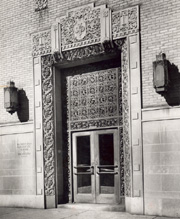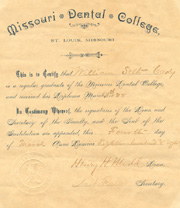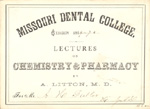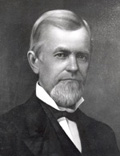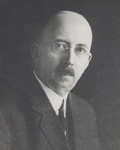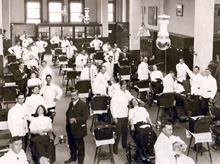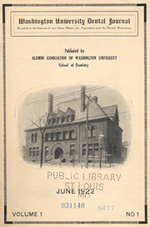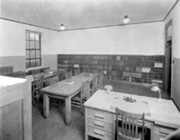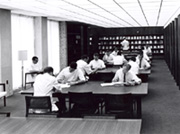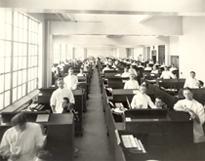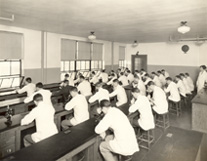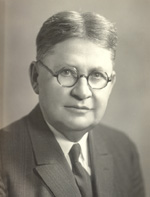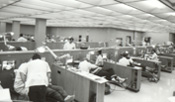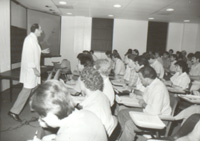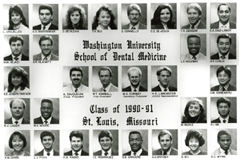| Home History Biographies Faculty & Alumni Timeline Related Articles Related Links |
The Washington University School of Dental Medicine, 1866-1991
Dental education was in its infancy in the mid-19th century. The profession itself was as well – more of a trade than a profession, more a mechanical art than a science. There were few formal schools; new dentists learned working under practicing dentists who were willing to share their few dental texts and pass on their practical knowledge. The need for able dentists was great, especially in the rapidly expanding west. Nowhere was this more obvious than in the state of Missouri. Between 1860 and 1870 Missouri grew from the 8th most populous state to the fifth most populous. In 1860 St. Louis ranked eighth in population in the United States; by 1870 the city, with a population of nearly 311,000, was the fourth largest city in the country. Practicing dentists were beginning to recognize the need for professionalizing their field by establishing local, state and national organizations and for formalizing dental education.
In 1864 dentist Henry E. Peebles began soliciting his fellow dentists in Missouri to join him in forming a state dental society. On October 31, 1865 the Missouri State Dental Society was established. At the Society’s first annual meeting a committee was formed to investigate the formation of a dental college under its auspices. A recommendation to open a school in St. Louis followed, especially encouraged by the offer from the St. Louis Medical College to share its lecture rooms, museum and hospitals. In the fall of 1866 the newly formed Missouri Dental College was incorporated. The Missouri Dental College was only the sixth dental school opened in the United States. It was the first dental school established west of the Mississippi River and the first in the world to be affiliated with a medical college.
The first course of lectures began on October 1, 1866 and closed on February 22, 1867, making it a course of five months duration. The following year the course of study was expanded to two years of lectures. There were eleven graduates in the first class – all were practicing dentists and some were among the founders of the college. Of the members of the first faculty, six held the M.D. degree and two held the D.D.S. degree. In its 125 years of existence, 15 deans presided over the school:
The School occupied six* different buildings:
In addition, in 1962 the Carlyn H. Wohl Research Center opened adjacent to the Scott Avenue Building, providing an additional twenty-eight thousand square feet of space and new quarters for the dental school library. In 1975, a four-story six thousand square foot addition at the west end of the school’s main building was completed, providing additional laboratory, clinic and faculty office space. In 1986 a five-story addition was completed (extending a previously recessed section of the building to the main building line along Scott Avenue and building in an inner courtyard of the existing building). There were changes to the name of the school over the years as well:
And changes to the degrees conferred:
In 1880 the Missouri State Dental Association passed a resolution permitting the Missouri Dental College to elect its own trustees. The following year the college was incorporated as its own entity, no longer under the auspices of the state association. In 1891 the St. Louis Medical College became the Medical Department of Washington University. The following year, under the deanship of Dr. Henry H. Mudd, the Missouri Dental College affiliated with the University as well, becoming the Dental Department of Washington University.
Sophia Wachsmuth was the first woman to receive a dental degree from Washington University, having been admitted on an experimental basis in 1908. She successfully completed her degree, graduating with the class of 1910. Two women graduated the following year. Female matriculants were scarce, however; less than twenty women had graduated from the Washington University School of Dentistry by 1942. Although the admission of women started to climb noticeably in the 1970s, the percentage of female class members never exceeded one-third of the total. In 1906 the Dental Department of Washington University began offering post-graduate courses in clinical dentistry. Beginning in 1939 post-graduate degree courses of study in dentistry were offered through the Washington University School of Graduate Studies. By the early 1950s the school offered post-graduate master of science degrees in the fields of Dental Medicine, Dental Pediatrics, Oral Surgery, Orthodontics, and Prosthetics. Other departments, such as Radiology, Operative Dentistry, Crown and Bridge, and Dental Materials offered courses of post-graduate study by the early 1960s.
Admission requirements for the Washington University School of Dental Medicine evolved over the years. In its first year the Missouri Dental College required that its candidates be of “good moral character” and have been in the reputable practice of dentistry since 1858. In 1880 the College adopted the American Dental Association’s resolution requiring “a good English education as a preliminary qualification for its Matriculants, to be ascertained by examination.” In 1886 the admission requirements stated that “candidates must have a good English education, as evidence of which a diploma from a reputable literary institution, teacher’s certificate, or other evidence of qualification will be accepted in lieu of an examination.” A recommendation made by the National Association of Dental Examiners requiring a high school diploma or its equivalent for admission were adopted for the 1906-07 term.
In 1921 the Washington University School of Dentistry instituted a requirement for one year of college as a prerequisite for admission. Declining admissions by mid-decade prompted the school to revert to the requirement of only a high school diploma – it was the only school in the country to do so – thus increasing the number of incoming freshmen in 1926 to sixty-one. However, a scathing Carnegie Foundation report issued in 1926 took the dental school to task for resorting to lowering admission standards in order to keep the school alive. The one-year preparatory college work requirement was reinstated for the 1927-28 school year, and the number of incoming first-year students fell to eight. In 1934 a program was established involving an optional two-year pre-dental college term leading to a B.S. degree in addition to the four-year dental degree. Beginning in 1939 the combined B.S./D.D.S. degree required three years of liberal arts instruction. In 1937 the American Association of Dental Schools adopted a minimum entrance requirement to all Class “A” dental schools of the completion of two years of education in an acceptable College of Liberal Arts, emphasizing study of the basic sciences including the study of zoology and chemistry. Washington University School of Dentistry complied with that entrance requirement.
During the Second World War an accelerated curriculum was offered, based upon the recommendations of the Council on Dental Education of the American Dental Association. The four academic years of study were compressed into three calendar years, requiring continuous terms including summers. Beginning in the 1950s the School of Dentistry catalog included a statement “urging” candidates to complete a baccalaureate degree before entering dental school, though two years of undergraduate study remained the entrance requirement. In 1972 the admission requirement was increased to three years of education in an accredited college of liberal arts, though that requirement was dropped back to two years of liberal arts education in 1981. A nationwide survey of dental schools by the Carnegie Foundation in 1921 had called attention to the need of added facilities for the Washington University School of Dentistry. The report suggested major changes: closer coordination with the medical school, hospitals and dispensary; erection of a new building with up-to-date equipment; and maintenance of an adequate endowment. The school received a “B” rating, which prompted the University to reconsider its commitment to the dental school. The Class “A” rating was returned in July of 1923 when the University promised to furnish a new facility. After a delay of four years, during which the University chancellor hoped private donations could be secured, the University committed money from its general fund and a new four-story building was started. In June 1928 the building at 4559 Scott Avenue was completed, at a cost of over $400,000.
The new building boasted three lecture rooms and an amphitheater for didactic instruction, three technical labs and three science labs. There was not only a large general clinic but also a diagnostic clinic, a children’s clinic with special chairs, an orthodontic clinic, an oral surgery and extraction clinic, and a radiography clinic.
The school obtained its first full-time dean, Benno E. Lischer, in 1933, and added full-time teachers in the basic medical and dental sciences and clinical subjects. A cooperative clinical research program involving the department of Dental Medicine, Oral Surgery, Prosthetics, and Pediatrics was developed. Teaching internships were established at Barnes and St. Louis Children’s Hospitals in the late 1930s. Undergraduate hospital dental experience was given to Washington University students in 1939 when Ruth Martin and Robert Harris, Jr. inaugurated a teaching and service clinic at the St. Louis Children’s Hospital.
The Washington University School of Dental Medicine’s tradition of dental research extends back to the beginning of the school, when its founders and early faculty members were national leaders in advancing the field of dentistry. Funding sources in the 20th century included the American Cancer Society, the National Institutes of Health, the National Science Foundation, and the United States Public Health Service. One of the best-known research projects was designed “to study radioactive nuclides in teeth and bone” (the “Baby Tooth Survey”). Begun in 1958, the Baby Tooth Survey studied strontium-90 absorption of children by examining their deciduous teeth. In 1973 the Washington University School of Dentistry compressed the course of study by reverting from the then-common four-year (nine months of study per year) curriculum to a three-year (eleven months of study per year) curriculum. This allowed utilizing the facilities at full-capacity for eleven months of the year and sped up the delivery of dentists to the nation’s health care system. It also meant an increase in class size from an average of sixty-three students to eighty-four students, straining classroom, clinic and laboratory facilities. A four-story, six thousand square foot addition to the main school building, completed in 1975, provided the necessary additional space.
In 1977 the dental school’s administration and faculty, led by Dean George D. Selfridge, decided to end the compressed three-year curriculum and return to the more traditional and more common four-year program. Students already enrolled in the three-year program were allowed to continue on that track, and were graduated in 1977, 1978, and 1979. The first four-year students were enrolled in 1977. The first discussions about closing the dental school came not in the 1970s but the 1870s. On August 4, 1875, at a meeting of the board of trustees, a discussion of the financial conditions of the school and its relation to the St. Louis Medical College brought forth a resolution from Dr. Charles W. Rivers to discontinue the school. The motion was lost. Dr. William Eames’ subsequent motion that the School continue and retain its affiliation with the St. Louis Medical College carried.
Discussions about closing the dental school arose in the early 1950s and again surfaced after the closure of the St. Louis University School of Dentistry was announced in 1967. At that time a devoted group of faculty and alumni vigorously defended the school, pledging increased assistance and financial support. An education, financial and remodeling proposal (put together by faculty members David Bensinger, Earl Shepard, Tom Moore, John Robert Ring, and Harold Rosenthal) was accepted by the University’s Board. The National Institutes of Health agreed to provide almost all of the funds necessary (nearly three million dollars) to renovate and re-equip the dental school’s building. The renovation (new heating, plumbing, lighting, air-conditioning, and teaching, research, and patient-care equipment) took place without interrupting the basic running of the school, and was completed in 1972. A rededication program was held in March 1973 to mark the completion of the school’s five-year renovation and rejuvenation plan.
In June 1989 the Board of Trustees moved to close the Washington University School of Dental Medicine. The decision was based upon budget deficits; increasing tuition rates; competition from less-expensive, state-funded dental schools; limited outside funding; and a declining student pool. The school’s transition to closure was guided by the dean, Richard Jay Smith. At the time of the closure announcement in 1989, there were full classes of incoming freshman and returning sophomores. These students were successfully placed in other dental school programs. All juniors and seniors were able to complete their degrees at Washington University by 1991. * Published histories of the dental school differ as to the location of the first home of the Missouri Dental College. Several indicate a location from 1866-1875 of Seventh and either Spruce or Myrtle Streets. The name of Myrtle Street was changed to Clark Street in 1884. (Spruce and Clark Streets run parallel to each other and are one block apart.) Some sources indicate that the school occupied the same location from its first classes in 1866 until the move to 1814 Locust Street in 1892. The minutes of the meetings of the Executive Committee of the Faculty do not mention the school moving in 1875; however, the clinic facilities used by the Missouri Dental College did move at that time. [Back] For more detailed histories of the Washington University School of Dental Medicine, see:
|
|||||||||||||||||||||||||||||||||||||||||||||||||||||||||||||||||||||||||||||||||||||||||||||||||||||||||||||||||||||||||||||||||||
| Home | History | Biographies | Faculty & Alumni | Timeline | Related Articles | Related Links | ||||||||||||||||||||||||||||||||||||||||||||||||||||||||||||||||||||||||||||||||||||||||||||||||||||||||||||||||||||||||||||||||||||
|
||||||||||||||||||||||||||||||||||||||||||||||||||||||||||||||||||||||||||||||||||||||||||||||||||||||||||||||||||||||||||||||||||||
 |
